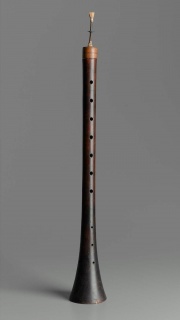Difference between revisions of "Apricot"
Jump to navigation
Jump to search
(username removed) |
(username removed) |
||
| Line 2: | Line 2: | ||
== Description == | == Description == | ||
| − | A deciduous, fruit bearing tree, ''Prunus armeniaca'', from the rose family. Apricot trees originated in China. A clear, water soluble gum exudes from open cuts in the bark. Apricot gum contains [http://cameo.mfa.org/materials/fullrecord.asp?name=arabinose arabinose], [http://cameo.mfa.org/materials/fullrecord.asp?name=galactose galactose], [http://cameo.mfa.org/materials/fullrecord.asp?name=mannose mannose], and [http://cameo.mfa.org/materials/fullrecord.asp?name=glucuronic | + | A deciduous, fruit bearing tree, ''Prunus armeniaca'', from the rose family. Apricot trees originated in China. A clear, water soluble gum exudes from open cuts in the bark. Apricot gum contains [http://cameo.mfa.org/materials/fullrecord.asp?name=arabinose arabinose], [http://cameo.mfa.org/materials/fullrecord.asp?name=galactose galactose], [http://cameo.mfa.org/materials/fullrecord.asp?name=mannose mannose], and [http://cameo.mfa.org/materials/fullrecord.asp?name=glucuronic%20acid glucuronic acid]. |
== Synonyms and Related Terms == | == Synonyms and Related Terms == | ||
| − | ''Prunus armeniaca''; apricot gum; fruitwood; fruit gum; darian gum; al-burquk (Arab.); praecox (Lat.); meruňka | + | ''Prunus armeniaca''; apricot gum; fruitwood; fruit gum; darian gum; al-burquk (Arab.); praecox (Lat.); meruňka obecná (Ces.); abrikostræet (Dan.); Aprikose (Deut.); albaricoque (Esp.); abricot (Fr.); albicocco (It.); abrikoos (Ned.); aprikos (Nor., Sven.); morela (Pol.) |
== Additional Information == | == Additional Information == | ||
| − | Schoch, W., Heller, I., Schweingruber, F.H., Kienast, F., 2004:[http://www.woodanatomy.ch/ Wood anatomy of central European Species]: Stone Fruit: Apricot,[http://www.woodanatomy.ch/species.php?code=PNAR Prunus armeniaca L.] | + | ° Schoch, W., Heller, I., Schweingruber, F.H., Kienast, F., 2004:[http://www.woodanatomy.ch/ Wood anatomy of central European Species]: Stone Fruit: Apricot,[http://www.woodanatomy.ch/species.php?code=PNAR Prunus armeniaca L.] |
== Authority == | == Authority == | ||
| − | * | + | * Ralph Mayer, ''A Dictionary of Art Terms and Techniques'', Harper and Row Publishers, New York, 1969 (also 1945 printing) |
* ''Ancient Egyptian Materials and Technologies'', Paul Nicholson, Ian Shaw (eds.), Cambridge University Press, Cambridge, 2000 Comment: R. Newman | * ''Ancient Egyptian Materials and Technologies'', Paul Nicholson, Ian Shaw (eds.), Cambridge University Press, Cambridge, 2000 Comment: R. Newman | ||
Revision as of 06:48, 24 July 2013
Description
A deciduous, fruit bearing tree, Prunus armeniaca, from the rose family. Apricot trees originated in China. A clear, water soluble gum exudes from open cuts in the bark. Apricot gum contains arabinose, galactose, mannose, and glucuronic acid.
Synonyms and Related Terms
Prunus armeniaca; apricot gum; fruitwood; fruit gum; darian gum; al-burquk (Arab.); praecox (Lat.); meruňka obecná (Ces.); abrikostræet (Dan.); Aprikose (Deut.); albaricoque (Esp.); abricot (Fr.); albicocco (It.); abrikoos (Ned.); aprikos (Nor., Sven.); morela (Pol.)
Additional Information
° Schoch, W., Heller, I., Schweingruber, F.H., Kienast, F., 2004:Wood anatomy of central European Species: Stone Fruit: Apricot,Prunus armeniaca L.
Authority
- Ralph Mayer, A Dictionary of Art Terms and Techniques, Harper and Row Publishers, New York, 1969 (also 1945 printing)
- Ancient Egyptian Materials and Technologies, Paul Nicholson, Ian Shaw (eds.), Cambridge University Press, Cambridge, 2000 Comment: R. Newman
- Wikipedia, the free encyclopedia, at http://www.wikipedia.com Comment: http://en.wikipedia.org/wiki/Apricot (Accessed Mar. 20, 2006) -for non-English terms
- Van Nostrand's Scientific Encyclopedia, Douglas M. Considine (ed.), Van Nostrand Reinhold, New York, 1976
- The American Heritage Dictionary or Encarta, via Microsoft Bookshelf 98, Microsoft Corp., 1998
- Art and Architecture Thesaurus Online, http://www.getty.edu/research/tools/vocabulary/aat/, J. Paul Getty Trust, Los Angeles, 2000
